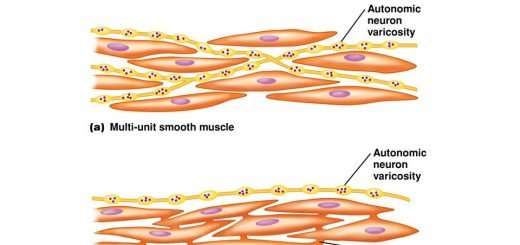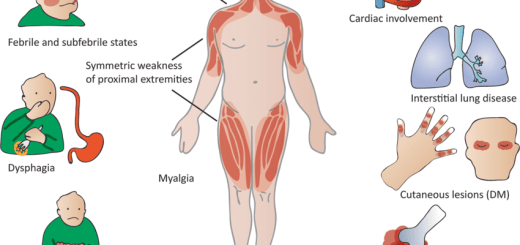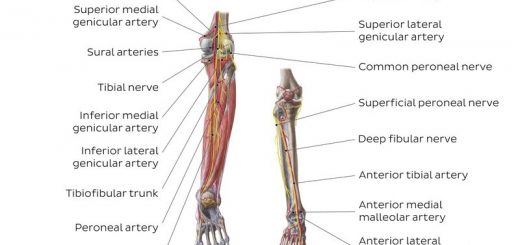Visual system, Bony orbit anatomy, contents and Nerves, Muscles and movements of Eyeball
The bony orbit is a four-sided pyramidal opening with its base opening in norma frontalis. The apex of the orbit directs posteriorly. The long axis of the orbit directs forward and laterally. The orbit has 4 walls; roof, floor, medial wall, and lateral wall:
Anatomy of bony orbit
The roof of the orbit, is formed of the Orbital plate of the frontal bone (large anterior part), and the lesser wing of the sphenoid (small posterior part). It shows the following features:
- The lacrimal fossa that lodges the lacrimal gland (its main part).
- Trochlear fovea that gives attachment to the trochlea of the superior oblique muscle.
- The optic canal gives passage to the Optic nerve and Ophthalmic artery.
The floor of the orbit, is formed by: Maxilla (medially), and Zygomatic bone (laterally). It shows the following features:
- Inferior orbital fissure (between the floor and lateral wall), it gives passage to the Infraorbital nerve, Infraorbital vessels, Zygomatic nerve, Emissary vein, and Branches from the sphenopalatine ganglion.
- The infraorbital groove converts into an infraorbital canal that opens into the infraorbital foramen.
The medial wall of the orbit; is formed of (from anterior to posterior): Lacrimal bone, Ethmoid bone, and a Body of sphenoid bone. It shows the following features:
- The lacrimal groove that lodges the lacrimal sac and is bounded by the lacrimal crests and leads inferiorly into the nasolacrimal canal that transmits the nasolacrimal duct.
- The anterior and posterior ethmoidal canals transmit the anterior & posterior ethmoidal and lead nerve and vessels respectively.
Lateral wall of the orbit; formed of Zygomatic bone (anterior), and the Greater wing of sphenold (posterior). It shows the following features:
A. Superior orbital fissure (between the lateral wall and the roof). It transmits the following structures from lateral to medial:
- Nerves: Outside the common tendinous ring: (Lacrimal nerve, Frontal nerve, Trochlear nerve). Inside the common tendinous ring: (Superior division of oculomotor nerve, Nasociliary nerve, Inferior division of oculomotor nerve, Abducent nerve).
- Superior and inferior ophthalmic veins.
- Meningeal branch of lacrimal artery.
- Orbital branch of middle meningeal artery.
B. Zygomaticofacial canal that transmits the zygomaticofacial nerve and artery.
C.Zygomaticotemporal canal that transmits the zygomaticotemporal nerve and artery.
Contents of the orbit
- Orbital fat.
- Eyeball.
- Muscles. levator palpebrae superioris & muscles of the eyeball.
- Nerves (sensory & motor).
- Vessels (ophthalmic artery & superior and inferior ophthalmic veins).
- Ciliary ganglion.
- Lacrimal gland.
- Fascia.
There are no lymph nodes inside the orbit.
Muscles of the eyeball
- Intrinsic muscles: (Sphincter pupillae, Dilator pupillae, Ciliary muscle). The 3 muscles are smooth muscles. The ciliary and the sphincter pupillae are supplied by parasympathetic fibers through short ciliary nerves (along the oculomotor nerve). The dilator pupillae muscle is supplied mainly by sympathetic fibers through long ciliary nerves.
- Extrinsic muscles: 4 recti (superior, inferior, medial, and lateral). 2 obliques (superior and inferior).
Recti muscles
Origin: common tendinous ring.
Insertion: Into the sclera in front of the equator.
Nerve supply: all are supplied by the oculomotor nerve except the lateral rectus supplied by the abducent nerve.
Action:
- Medial and lateral recti produce a medial and lateral deviation of the cornea respectively.
- Superior and inferior recti produce superior and inferior movement of the cornea respectively accompanied with medial deviation (Adduction).
Oblique muscles
- Origin: the wall of the bony orbit.
- Insertion: sclera behind the equator.
- Nerve supply: superior oblique is supplied by the trochlear nerve while the inferior oblique is supplied by the oculomotor.
- Action: the superior and inferior oblique produce inferior and superior movement of the cornea respectively with lateral deviation (abduction).
Movements of the eyeball
- The medial rectus ADDUCTs the eye.
- The lateral rectus ABDUCTs the eye.
- The superior rectus moves the eyeball upward and ADDUCTs the eye.
- The inferior rectus moves the eyeball downward and ADDUCTs the eye.
- The superior oblique moves the eyeball downward and ABDUCTs the eye.
- The inferior oblique moves the eyeball upward and ABDUCTs the eye.
- Intorsion: is the inward rotation of the eyeball done by the superior rectus and superior oblique.
- Extorsion: is the outward rotation of the eyeball done by the inferior rectus and inferior oblique.
The superior oblique and inferior oblique muscles are inserted behind the equator of the eye.
Nerves of the orbit
A. Sensory nerves:
1. Optic nerve: it is the sensory nerve for vision.
Origin: the ganglion cells of the retina.
Course:
- The nerve is 4 cm long, it pierces the sclera posteriorly, medial to the center of the eyeball.
- The nerve is completely enclosed inside a meningeal sheath that is the extension of the 3 meninges surrounding the brain.
2. Branches of the ophthalmic nerve:
- Lacrimal nerve: the smallest branch that supplies the lacrimal gland, adjacent conjunctiva, and eyelid.
- Nasociliary nerve: the medium-sized one that gives a sensory branch to the ciliary ganglion.
- Frontal nerve: the largest branch that divides into supratrochlear and supraorbital nerves, and it is the highest structure in the orbit.
3. Zygomatic nerve.
B. Motor nerves:
- Occulomotor nerve: it supplies all the extraocular muscles (recti & oblique) except the superior oblique & lateral rectus. It also gives parasympathetic supply to the ciliary and sphincter (constrictor) pupillae muscles. It is divided into 2 branches (superior & inferior divisions).
- Trochlear nerve: the 4th cranial nerve and the smallest of all. It supplies only the superior oblique muscle.
- Abducent nerve: it supplies the lateral rectus muscle.
Ciliary ganglion
It is the smallest of the 4 parasympathetic ganglia of the head and neck.
Roots:
- Sensory: nasociliary nerve.
- Sympathetic: plexus around the internal carotid artery.
- Parasympathetic: nerve to inferior oblique.
Branches: the short ciliary nerves to the sphincter papillae and ciliary muscles.
Ophthalmic artery
Origin: from the internal carotid artery.
Course and relations:
- It enters the orbit through the optic canal below the optic nerve.
- Then, it passes lateral to the nerve.
- Inside the orbit, it crosses above the nerve from lateral to medial.
- Here the ophthalmic artery is accompanied by the superior ophthalmic vein and nasociliary nerve.
Termination: by dividing into supratrochlear and dorsal nasal arteries.
Branches:
- The central artery of the retina.
- Lacrimal artery.
- Palpebral branches.
- Muscular branches.
- Meningeal branches.
- Anterior ethmoidal artery.
- Posterior ethmoidal artery.
- Supratrochlear artery.
- Infratrochlear artery.
- Dorsal nasal artery.
- Ciliary arteries; anterior and posterior.
Veins of the eyeball
- Superior & inferior ophthalmic veins: They drain the structures inside the orbit and into the cavernous sinus after passing through the superior orbital fissure.
- The central vein of the retina: It accompanies the central artery of the retina inside the optic nerve and ends in the cavernous sinus.
Fascia & ligaments of the eyeball
- The fascial sheath of the eyeball (Tenon’s capsule): it is a thin membrane that covers the eyeball from the optic nerve till the corneo-scleral junction.
- Check & suspensory ligaments.
- Orbital septum (palpebral fascia).
You can subscribe to Science Online on YouTube from this link: Science Online
You can download the Science Online application on Google Play from this link: Science Online Apps on Google Play
Eyes structure, Histological organization of the fibrous and vascular coast of the eye
Retina function, anatomy, layers and accessory structures of the eye
Sense of vision, Refractive media of the eye, Corneal reflex & Pupillary pathways
Retinal receptors, Photochemistry of vision, Steps of phototransduction in rods & Retinal output
Nystagmus types, causes, symptoms Development of CNS & Abnormalities of Spinal cord











